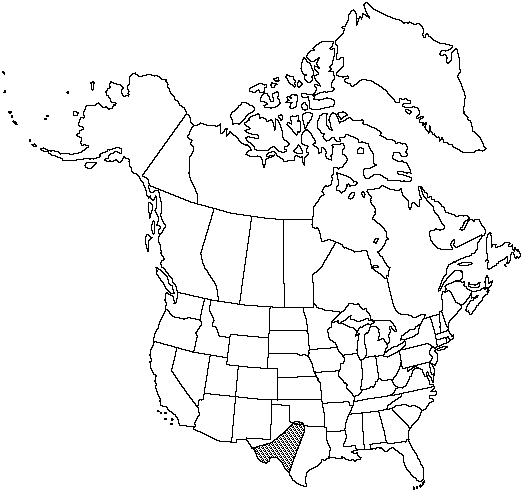Difference between revisions of "Cheilanthes horridula"
Amer. Fern J. 8: 94. 1918.
FNA>Volume Importer |
imported>Volume Importer |
||
| (6 intermediate revisions by 2 users not shown) | |||
| Line 12: | Line 12: | ||
|name=Pellaea aspera | |name=Pellaea aspera | ||
|authority=(Hooker) Baker | |authority=(Hooker) Baker | ||
| + | |rank=species | ||
}} | }} | ||
|hierarchy=Pteridaceae;Cheilanthes;Cheilanthes horridula | |hierarchy=Pteridaceae;Cheilanthes;Cheilanthes horridula | ||
| Line 27: | Line 28: | ||
|elevation=100–1400 m | |elevation=100–1400 m | ||
|distribution=Okla.;Tex.;n Mexico. | |distribution=Okla.;Tex.;n Mexico. | ||
| − | |discussion=<p>The scabrous, pustulose hairs of Cheilanthes horridula make it one of the most distinctive species of Cheilanthes in North America. As currently circumscribed, the species includes two sexually reproducing cytotypes that may be given formal recognition when their morphologic characteristics and distributions are sufficiently well known.</p> | + | |discussion=<p>The scabrous, pustulose hairs of <i>Cheilanthes horridula</i> make it one of the most distinctive species of <i>Cheilanthes</i> in North America. As currently circumscribed, the species includes two sexually reproducing cytotypes that may be given formal recognition when their morphologic characteristics and distributions are sufficiently well known.</p> |
|tables= | |tables= | ||
|references= | |references= | ||
| Line 36: | Line 37: | ||
-->{{#Taxon: | -->{{#Taxon: | ||
name=Cheilanthes horridula | name=Cheilanthes horridula | ||
| − | |||
|authority=Maxon | |authority=Maxon | ||
|rank=species | |rank=species | ||
| Line 51: | Line 51: | ||
|publication year=1918 | |publication year=1918 | ||
|special status= | |special status= | ||
| − | |source xml=https:// | + | |source xml=https://bitbucket.org/aafc-mbb/fna-data-curation/src/2e0870ddd59836b60bcf96646a41e87ea5a5943a/coarse_grained_fna_xml/V2/V2_305.xml |
|genus=Cheilanthes | |genus=Cheilanthes | ||
|species=Cheilanthes horridula | |species=Cheilanthes horridula | ||
Latest revision as of 20:22, 5 November 2020
Stems short-creeping, usually 4–7 mm diam.; scales uniformly brown or with poorly defined, dark central stripe, linear-lanceolate, straight to slightly contorted, loosely appressed, persistent. Leaves clustered, 5–30 cm; vernation noncircinate. Petiole black to dark brown, rounded adaxially. Blade linear-oblong to lanceolate, pinnate-pinnatifid to 2-pinnate at base, 1–4 cm wide; rachis rounded adaxially, with scattered linear-lanceolate scales and dimorphic pubescence, abaxially sparsely hirsute, adaxially covered with tortuous, appressed hairs. Pinnae not articulate, dark color of stalk continuing into pinna base, basal pair not conspicuously larger than adjacent pair, usually equilateral, appearing pustulose adaxially. Costae green adaxially for most of length; abaxial scales multiseriate, lanceolate, truncate to subcordate at base, without overlapping basal lobes, somewhat inconspicuous, the largest 0.4–0.6 mm wide, loosely imbricate, not concealing ultimate segments, erose, not ciliate. Ultimate segments narrowly elliptic to elongate-deltate, not beadlike, the largest 3–5 mm, abaxially and adaxially scabrous with stiff, usually pustulose hairs. False indusia marginal, slightly differentiated, 0.05–0.25 mm wide. Sori ± continuous around segment margins. Sporangia containing 64 spores. 2n = 58, 116.
Phenology: Sporulating summer–fall.
Habitat: Rocky slopes and ledges, usually on limestone
Elevation: 100–1400 m
Distribution

Okla., Tex., n Mexico.
Discussion
The scabrous, pustulose hairs of Cheilanthes horridula make it one of the most distinctive species of Cheilanthes in North America. As currently circumscribed, the species includes two sexually reproducing cytotypes that may be given formal recognition when their morphologic characteristics and distributions are sufficiently well known.
Selected References
None.